During recent Bird Photography features I’ve been emphasizing some single-species photo sessions, and sometimes it helps to show a variety of images taken during a single photo session. But after getting my best image of Western Grebe hatchlings back-riding before an extended cloudy-rainy period (photo included here), with the promise of a sunny Sunday I was poised for a big day of birding, emphasizing camera work. I planned to devote plenty of time and cover a lot of ground to connect a lot of seasonal hotspots – some with a single species in mind, others with the potential of having a variety of birds on hand, with plenty of surprises along the way.
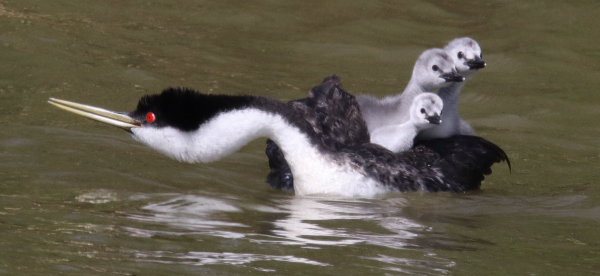
Sunday was indeed a beautiful sunny day, sunrise to sunset, but just as important was the fact that the wind was calm or nearly calm throughout the day, which created beautiful water as a base for the biggest surprise of the day – many duck broods! But I’m getting ahead of myself; let me take you through the day chronologically, as rapidly as possible – ha. Just let me start by saying, not only was it a signature early summer day, but it was one of my best days of birding this year!
The photographs I took are a fitting mix to illustrate my time afield, except at my first hotspot stop, where I didn’t take a single photograph. I returned to the Eastern Bluebird location in the James River Valley, but although I saw the male a couple times, I opted to move on after an extended wait in a couple positions with similarly distant Cedar Waxwings, Tree Swallows, American Robins, and Chipping Sparrows on hand, but sometimes you get the feeling that although everything else gels, the birds just aren’t into it, so I opted to move on with plenty of other locations to check out.
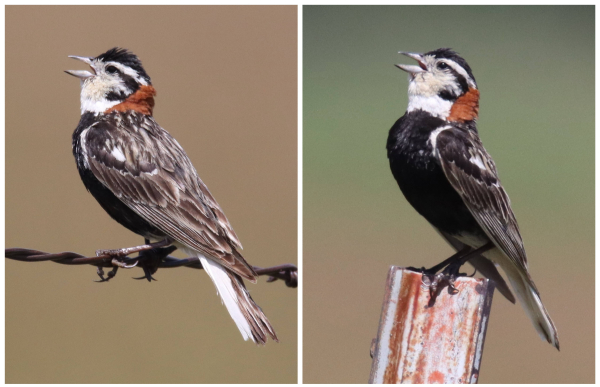
Taking a broad swing to the western side of the Missouri Coteau, the hill country broken by myriad wetland basins, I quickly encountered more pairs of Western Grebes with back-riding downy hatchlings, and how could I pass up any chance to photograph these enchanting waterbirds where there was also a variety of ducks on hand. The next hotspot was the longspur haven, a small quarter-mile area that has something very special that attracts a small nesting population of Chestnut-collared Longspurs. I sighted 6 males singing and performing flight displays, although that was certainly a minimum number, but these birds seemed unusually wary throughout my photo stop.
Finally, at the very east end of the grassland, where I could pull in to the corner of the hotspot, a singing-displaying male permitted my careful approach. I photographed as it sang and perched on posts and barbed wire until it would take off into a dramatic flight display, singing all the way. It always seemed to return to that corner position though, and I approached it 2 other times and was pleased that the territorial longspur never left as a result of my arrival. In fact, it provided my best photos of the species, acting as a true species ambassador for me, singing with his black underside facing me first, and later with his back to me, showing its chestnut collar well. It was fun to have the air filled with the tinkling songs of longspurs, with views of Grasshopper Sparrows too, along with Eastern and Western Kingbirds.
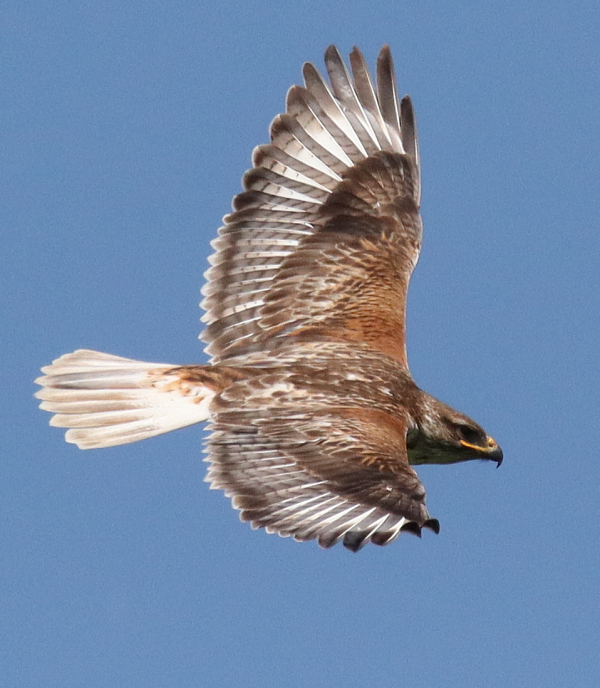
While faced with a flat tire deep in the Dakota outback, a white-tailed Ferruginous Hawk circling overhead could not be overlooked as a prime photo subject (600mm zoom lens, f-8 aperture, 1/3000 shutter speed, 800 ISO).
|
Just a couple miles to the south I checked on the 2 Ferruginous Hawk nests I’ve been monitoring, with the northern nest showing at least 4 fast-growing nestlings, now with still-growing feathers covering their back, wings, and tail. At the south nest the big adult female was perched on the rim, as usual, with similar-looking feathers on the grow on the backside of the nestlings. I took a nearby side trip to check for ducks and grebes along the shore of a large lake, noting a new brood of 9 tiny Blue-winged Teal with an adult female and many other ducks and Eared Grebes near shore. I turned around by backing into an approach to a farm field, then retraced my route a mile back to the hawk nest, just in case there was an adult in flight or another photo option.
As I approached the spot where I could view the nest from a distance with binoculars, my car began jumping and bumping followed by some banging – did I have a flat tire? When I stopped and inspected the rear right wheel, not only was the tire flat, it was impaled by a long curved metal spike that broke off a hay rake. Apparently, when I backed into the approach, my tire found the sharp spike that literally ripped a long tear in the sidewall of the tire. I was a long way from anywhere on a Sunday – hmm.
I had all kinds of safety equipment, including everything to fix a flat tire, but this tire was not fixable! So I needed to replace the torn the tire, using the spare – no sweat (maybe some sweat). But strike 2, I couldn’t get even 1 lug nut to turn – the result of the tire shop tightening them with a high-torque power wrench – hmm! I tried turning all the lugs again, but no luck. About that time I spied the adult male Ferruginous Hawk flying over the nest tree some distance away, but he soared ever-closer – great! I grabbed my camera and began photographing.
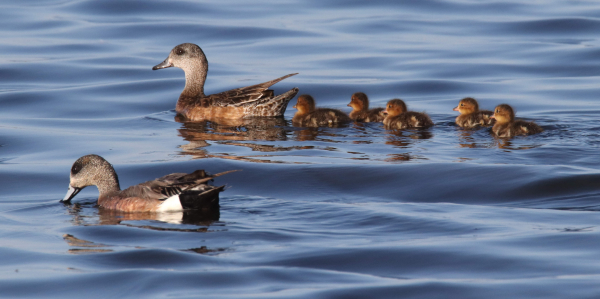
Standing below his circling flight, I figured I’d only get shaded silhouettes with the sun lighting his topside, but as he shifted away, he began banking on the far side of his circles, which gave me a chance to photograph the top of his wings, tail, back, and head as he turned toward my position. As he drifted away, I heard a vehicle and in a moment a big black pickup pulled up next to me and a little boy in the passenger’s seat asked, “Do you need any help?” His Dad was probably going to provide any real help – if he could turn the lug nuts on the wheel. I thanked them and explained the need for a power tool, and the boy with the Spiderman T-shirt and his Dad, who turned out to be his Gramps, said he would give it a try.
Try? The guy made me look like a wimp, turning the lug nuts off without a pause. When I said I could change the tire, he was already getting the tire jack in position and happily said, “I can do it quick,” and quick he was! I asked “Spidey” if he would like a cookie, and he did, and by that time his Grandfather was putting the jack back in the open trunk. WoW. I told him that not only was he traveling with a superhero (in the Spiderman shirt) but that he was a superhero too, and with a quick handshake they were off as quick as they could get into their superhero truck – Thanks a million! And would you believe it turned out that we are distant relatives living 40 miles apart? Ya never know what you might find out in the outback hills of Dakota.

Whew, back on the road again, the closer I drove to home the more duck broods I began to encounter, and that’s when it became a bit of a mission to cover my usual ‘south of home’ drive to Herb’s Lake and Charo Marsh and points along the way to see if other broods were active in the calm afternoon waters. Indeed, by the end of the drive I logged 20 duck broods, several just hatched! The totals were 6 Blue-winged Teal broods numbering 9, 7, 1, 12, 10, and 7 ducklings; a trio of Redhead broods numbering 7, 8, and 9 ducklings; 10 Mallard broods numbering 4, 6, 12, 7, 7, 8, 3, 2, 8, and 6 ducklings; and the rare brood was composed of 6 newly hatched American Wigeons. That’s a total of 139 ducklings in 20 broods, almost a mean average of 7 ducklings per brood.
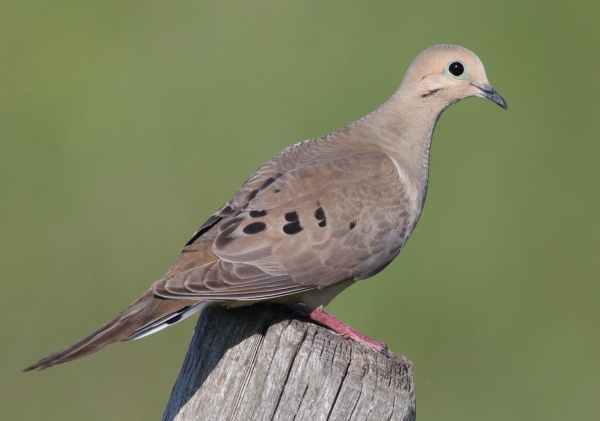
Another interesting observation was that 3 broods were accompanied by an adult male with the attendant female – 2 Blue-winged Teal and the American Wigeon; usually only the female raises the brood, males congregating in “bachelor groups” as they molt into eclipse plumage. It’s also noteworthy to point out that 5 of the broods were present along the west side of Herb’s Marsh, an extension of Herb’s Lake that is separated by a handy country road. As I drove up it seemed the entire west side was covered with ducklings with adult ducks mixed among them, but as I drove closer, the ducklings collected around their respective females that revealed 3 Mallard broods, 1 Blue-winged Teal brood, and 1 American Wigeon brood.
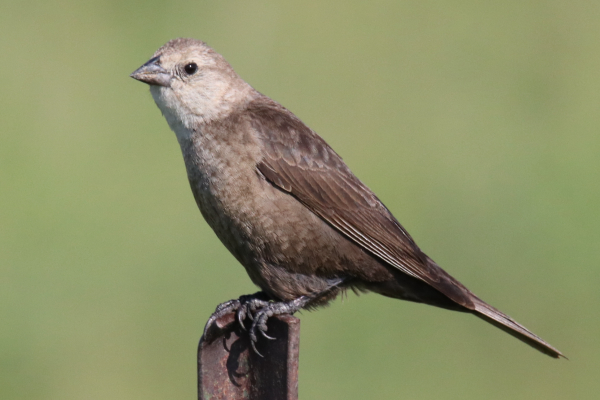
The variety of the birds and the varied collection of photos I managed to take made my day, and each hotspot seemed to require different photographic techniques and camera settings – except that I used my “new” standard ISO 800 setting throughout the sunny day at the variety of locations and surroundings. In some cases, I used a wide aperture setting, like the f-10 for the duck broods and grebe families to try to get all the birds in focus. Under other conditions, such as when photographing the tiny Chestnut-collared Longspurs, I wanted to emphasize the bird and its actions by turning the background grasses out of focus to create a uniformly colored setting that made the songbirds ‘pop.’
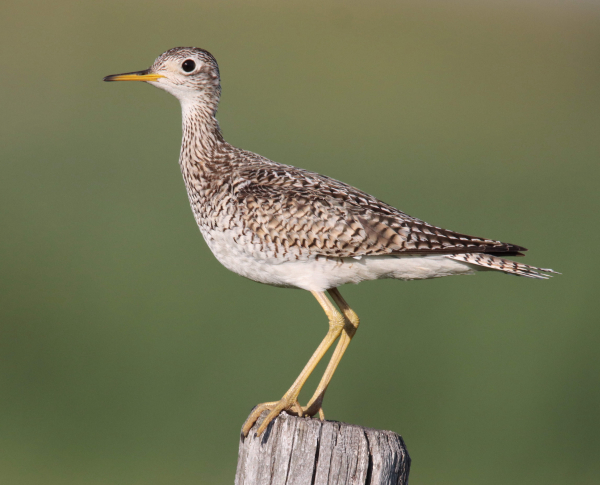
An f-7 aperture did the trick in that case in the best possible way, while providing a corresponding ultra-fast shutter speed of 1/2000 of a second. That’s because by using the Av setting on my camera, I set the aperture to get the desired effect, and the camera provided the corresponding shutter speed. I check the shutter speed as I’m photographing, and if the shutter speed isn’t fast enough I simply switch the aperture from f-10 to f-8, for example, to get a corresponding faster shutter speed.
As for the circling Ferruginous Hawk, I used a medium f-8 aperture to keep the full wingspan in focus, and the overhead direction of the sunlight provided an ample shutter speed to stop the action of the flight. Even with the best camera settings, photographing broods of ducklings always presents a bit of a conundrum as I try to watch the head positions of the ducklings, waiting to get as many of them as possible with their head turned in the same direction as a group – with the female a must too. That often comes down to taking several photos when the ducks’ positions look best, then reviewing and selecting the best photos in the “editing darkroom” (using computer software).
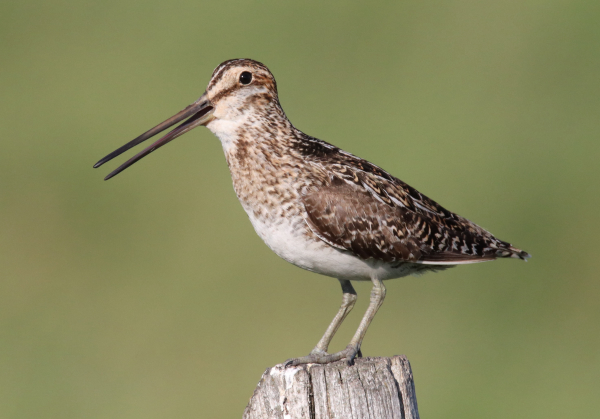
After leaving the last Redhead brood with 9 tiny yellow ducklings, I continued to the Grande Prairie, where I encountered a line-up of prairie birds perched on fenceposts – some weathered wood posts, some rusted metal posts. I’m not a big fan of photographs of birds taken on fenceposts and wires, but I’ve been getting such beautiful opportunities to photograph birds on those common perches, and as my friend Bill always says, “That’s what birds do.” Taking portrait photos of 4 brown birds with a tight aperture that blurred the background vegetation yielded some really sharp images of a Mourning Dove, Brown-headed Cowbird, Upland Sandpiper, and Wilson’s Snipe along a single fenceline just before reaching the Lost Road (photos and tech info included as illustrations for this article).
It was quite a day of birding, with many photo opportunities that required a mixed bag of photo techniques and camera settings, but every day should be that much fun, and that rewarding. To sum things up beyond that, it’s a good thing the sun eventually sets, ’cuz you never know how much longer I might continue trying to get the next photographs of birds – but there’s always tomorrow. Last week, when I encouraged fellow birders to make a concerted effort to celebrate the first week of summer with some quality birding, I followed through in a big way the first Sunday of summer. Now, what are we doing over the 4th of July? Good Luck!
Article and Photographs by Paul Konrad
Share your bird photos and birding experiences at editorstbw2@gmail.com